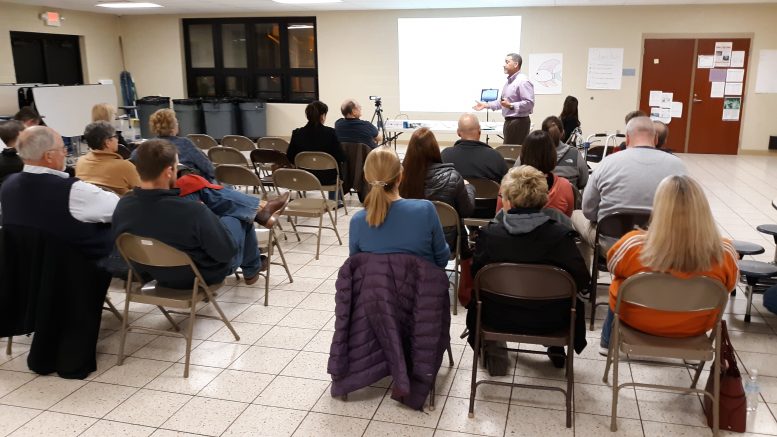By JAN LARSON McLAUGHLIN
BG Independent News
David Conley used the same numbers to convince a different audience Thursday evening that Bowling Green City School District faces tough times ahead if steps aren’t taken to stabilize district revenue.
Conley, a financial consultant from Rockmill Financial Inc., was planning to go over funding options for renovated or new school buildings with the district’s finance task force. But he never got past discussion of the district’s five-year budget and the current funding structure.
Though the numbers were the same, the focus of this meeting was a little different. Conley has been meeting with the board of education to explain the district’s current tax levy situation and how to change it to help shore up the budget.
The message to the finance task force was more an explanation of why the district needs to renew the tax revenue it generates now, and why it will likely need more in the near future.
The district faces the possibility of having five tax levies on the ballot in three to five years. Three are current levies that will need to be renewed, one would be a new levy for operating funds, and one would potentially be to fund new or renovated buildings.
“We have a fairly daunting task ahead of us as a community,” Conley said.
“Your taxing model give me a headache – and I do this for a living,” he said.
So the school board is working on tidying up its taxing model.
But it’s the finance task force’s job to come up with the best funding model for building plans being formed by the facilities task force. Earlier this week, the facilities task force seemed to narrow down its choices to three building options, with the following cost estimates:
- One new consolidated elementary for all 1,416 students: $36.1 million now; $39 million in a year.
- Renovate all three elementaries: $28.4 million now; $31.3 million in a year.
- Build a new Conneaut, a new Kenwood, and renovate Crim: $34.3 million now; $38.3 million in a year.
The finance task force must look at the best option to pay for the new or renovated buildings – keeping in mind what type of tax levy the local voters will support. The options for paying for buildings include:
- Traditional income tax
- Earned income tax
- Property tax
- Combined income and property taxes
But Thursday’s discussion never got past the school district’s five-year budget forecast. Conley explained that every school district in Ohio must submit five-year plans, with updates every six months.
School boards use the forecasts to manage their districts. And the state uses the forecasts to determine if the state needs to intervene. If the state senses that a district can’t cover its expense, it first declares “fiscal caution.” If the problems persist, it could become “fiscal watch,” and then “fiscal emergency” when the state takes over.
“You don’t ever want the state of Ohio taking over your district and telling you how to teach your kids,” Conley said.
Bowling Green’s budget includes projected expenditures of about $33 million a year. As with most districts, the revenues are flat but the expenses are growing. That’s where new levies come in.
“It’s always smart to do your levy before you get too deep in the hole,” Conley said.
The district carries a cash balance of nearly $14 million – which is an appropriate amount considering the district’s risk factors of relying on a series of five-year tax levies. If the district were to make some of those levies continuing, it would not need such a large balance, Conley said.
Former school board member Ellen Dalton asked about the success rate of continuing levies, since voters seem to prefer short-term levies.
Conley said some voters see short-term levies as a way to “keep a school district honest.” But in reality, it costs more money to keep going on the ballot for money that will continue to be needed.
“The fact of the matter is, expenses never go down,” he said.
If the levy renewals are not passed by voters, the district would risk being taken over by the state by 2022.
“It reflects how quickly you can go broke if your levies aren’t renewed,” Conley said.
Bowling Green School District has not gone back to voters for new money for nine years – which is a sign of good money management, Conley said.
“The district has been doing a good job with the money they’ve got,” he said. As for deficit spending, that is a natural phenomenon for school districts in Ohio, not a sign of poor management, he added.
But some task force members were skeptical of the accuracy of the five-year forecast numbers.
Steve Bateson asked if the proposed tax revenue from the Rover Pipeline was included in the budget.
“We can’t count on it. We haven’t seen it,” school treasurer Cathy Schuller responded.
Bateson noted that the deadline for an appeal had passed, with the pipeline not challenging the tax calculations.
“They’ve not paid yet either,” Schuller said of the $800,000 projected tax revenue from the pipeline.
Conley also pointed out that the pipeline revenue is an uncertainty since the state sometimes takes that revenue from some districts to give to others that are struggling financially.
“They siphon it off and send it someplace else,” he said.
“Lobbyists are being paid a lot of money to take money away from you,” he said. “You’re on the radar as a rich district.”
Task force member Richard Strow also questioned the expenditures listed in the five-year forecast, since they do not reflect the 10 percent turnover in personnel last year.
Without that decrease shown in the budget, the forecast is “completely and totally flawed,” he said.
Conley said the budget will be updated in six months, and will reflect changes as they occur. “It’s impossible to be perfect. It’s even impossible to be roughly accurate.”
Schuller also noted that the 10 percent personnel turnover was an anomaly, and not a trend that should be reflected in the budget. High School Principal Jeff Dever said the state teachers retirement system saw drastic changes, which created a mass exodus of staff.
But Strow said the five-year forecasts historically paint a much more dire picture than reality. He suggested that real numbers show “we’re quite a ways away from needing additional levy funds.”
However task force member Frank McLaughlin said that governmental agencies have to be conservative in their projections, and budget for every possible contingency, especially for personnel expenses.
The finance task force will meet again next week, Feb. 13, at 7 p.m., in Crim Elementary School, to continue the discussion on financing new or renovated buildings.


